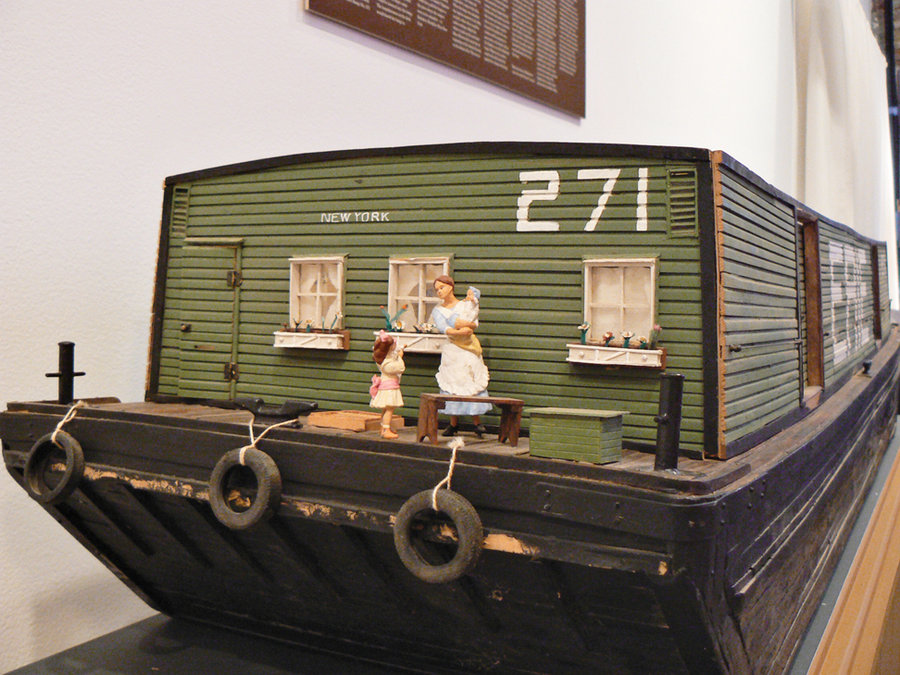If you are descended from one of the millions of immigrants who gained entry to the United States through Ellis Island, you can conclude at least one fact about your pond-jumping ancestors – they probably didn’t own much more than the things they could fit in a trunk.
Around the turn of the century, foreigners in first and second class didn’t have to go to Ellis Island. After a cursory medical examination on the ship, they were allowed to disembark at a port on the mainland and be on their merry way. For many thousands, that port was Hoboken, home to four key passenger steamship lines by the time Ellis Island opened in 1892.
In fact, according to Hoboken Historical Museum collections manager David Webster, almost 50 percent of the immigrants who came to the United States from Europe in the 1910s docked first in Hoboken. In a commute all too familiar to some Hudson County residents today, steerage passengers would arrive in Hoboken only to immediately take a ferry to New York for immigration processing, followed by a ferry back to Hoboken or Jersey City to catch a train to points beyond.
“The vast majority of people did not come in cabins, they came in steerage.” – Christina Ziegler-McPherson
____________
Looking below decks
Guest curator Christina Ziegler-McPherson, an immigration historian who lives in Hoboken, said the new exhibition is set apart by its focus on the experience of traveling to America in steerage, the deck reserved for poor passengers.
“Most exhibits that deal with historic shipping deal with the grand old luxury liners and the first class cabin experience,” she explained, “but the vast majority of people did not come in cabins, they came in steerage.”
(Indeed, Alfred Stieglitz’s acclaimed photograph “The Steerage,” which captures the spatial and class dichotomy between first-class and steerage passengers, was taken on one of the steamers that docked in Hoboken. Stieglitz lived in Hoboken for a time.)
The exhibit features photographs, shipping manifests, travel documents, trunks, and other artifacts from the people that came through Ellis Island and Hoboken. Some of the materials were loaned from other collections, though none came from the Ellis Island immigration museum, which is still recovering from the effects of Superstorm Sandy.
As a way of documenting America’s growth during this period, the exhibit includes all four U.S. flags that would have flown over Ellis Island while it served as an inspection station, ranging from 44 to 48 stars.
Hoboken grew in tandem with the nation as immigrants stayed in town to work in the docks, hotels, and saloons. By 1910, Hoboken’s population hit a mindboggling 70,324 – seven times what it had been only a half century earlier.
At the time, the town was dominated by German immigrants and their children, with significant populations of Italians and Irish to boot. (Puerto Ricans arrived in the 1950s and 1960s to work in the Tootsie Roll factory and other factories that recruited them, and young professionals and artists gravitated to Hoboken in the 1970s and latter decades from other nearby towns).
Ziegler-McPherson became interested in Hoboken’s place in the intricate web of trans-Atlantic travel when she moved to the city nine years ago. She has literally written the book on this topic – her 2011 paperback “Immigrants in Hoboken: One-Way Ticket, 1845-1985” looks at the successive waves of foreigners who gave Hoboken its unique character through the years. So fundamental is immigration to the history of Hoboken that her specialized study may be the best history book covering Hoboken in the first half of the twentieth century. Using her knowledge of Hoboken’s immigration history, Ziegler-McPherson prepared the texts that narrate the exhibit for visitors.
Expert opinions
In addition, Ziegler-McPherson has recruited eight guest experts, most of them locally based, to share their specialized knowledge within the world of immigration. For example, on Dec. 14, Brooklyn College professor Dr. Jerome Krase will give a speech on the vernacular architecture of Italian American neighborhoods.
“There’s some really good people who are coming,” said Ziegler-McPherson, “a really good mix of people who are going to talk about immigration historically and people who are going to talk about the contemporary issues.” The series will include a Sept. 28 lecture by Julia Preston, who has been covering the current Latin-American refugee crisis for the New York Times.
Ziegler-McPherson said she was particularly excited about Ellis Island librarian Jeff Dosik, who will present “tales of Ellis Island” on Nov. 16. “He’s incredibly knowledgeable,” she said. “If I need to know something about the process at Ellis Island, I’ll write to him.”
Ziegler-McPherson will kick off the exhibition with her own lecture on the business model developed by the Hamburg-America Packet Company, one of the four passenger lines based in Hoboken, at 2 p.m. on Sunday. An opening reception will follow. All of the other lectures will take place at 4 p.m.
The Hoboken Historical Museum is open from 2 to 7 p.m. from Tuesday to Thursday, from 1 to 5 p.m. on Fridays, and from noon to 5 p.m. on weekends. It is located at 1301 Hudson St. in the former Bethlehem Steel shipyard building. Admission is $2 for all but children and museum members. More information about the exhibit and a full list of the speakers can be found online at www.hobokenmuseum.org.
To read the Hoboken Reporter’s extensive 2002 story about the waves of immigration in Hoboken and various ethnic groups, go to http://tinyurl.com/ljlaje2.
Carlo Davis may be reached at cdavis@hudsonreporter.com.
